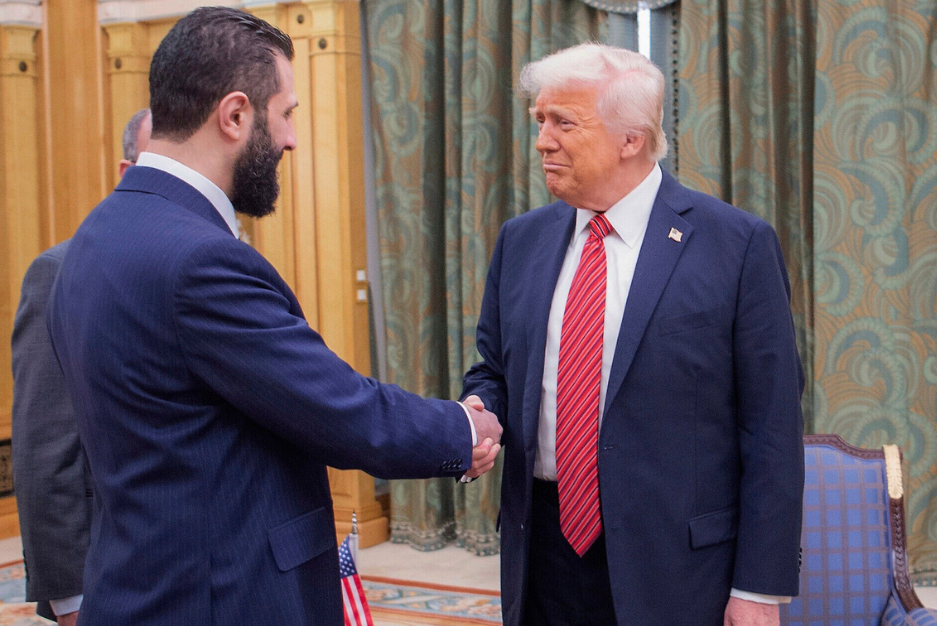The Washington calculus: expected outcomes of Al-Sharaa's visit to Washington

Speaking at the Manama Dialogue in Bahrain, hosted by the International Institute for Strategic Studies (IISS), U.S. Special Envoy for Syria Thomas Barrack announced that Syrian President and HTS leader Ahmed al-Sharaa would visit Washington. It will be the first time a Syrian head of state has visited Washington since the country's independence in 1946. For this reason, the meeting is expected to be a "historic" gathering, as Syrian Foreign Minister Asaad al-Shaibani noted, and to open a "new chapter" in U.S.-Syria relations. It is worth noting that Trump met with al-Sharaa in Riyadh on May 14, in a meeting facilitated by Saudi Arabia's de facto ruler Mohammed bin Salman. The talks will cover many of the Trump administration's remaining "unresolved" files on Syria. The first of these will be the new Syrian administration's participation in the international anti-ISIS coalition.

Members of the Islamic State of Iraq and al-Sham and Jabhat al-Nusra together during Eid al-Adha in mid-October 2013; Aaron Y. Zelin
There is widespread scepticism about HTS's potential participation in the U.S.-led anti-ISIS coalition, due to its lineage as Jabhat al-Nusra (JN). This perception, however, oversimplifies a complex, non-linear relationship that evolved from "frenemies" (2013–2014) to open hostility.
From its 2012 inception, JN, led by al-Julani, practiced strategic ambiguity, concealing its transnational affiliations (to ISIS and Al-Qaeda) to maintain cohesion with other Syrian insurgent factions.(1) This pragmatic and locally-focused approach soon created an ideological rift with its patrons.
The ISIS leadership, sensing al-Julani's "reluctance" to obey directives, demanded total allegiance, branding all non-adherents as "apostates" to be "liquidated." JN rejected this totalizing takfiri doctrine and refused to participate in infighting against other Islamist factions.
This fundamental divergence was articulated by former U.S. Special Representative James Joffrey. He identified "two variants of Al Qaeda" emerging in Syria: ISIS, which was a "transnational movement" to "do terror everywhere," and al-Nusra. Joffrey noted he "didn't see... Jolani and al-Nusra really buying into this," observing that while ISIS was an "international terrorist organization on steroids," al-Nusra "was not against owning terrain but mainly it was focused on fighting Assad.”
The ideological and organizational split between the groups reached its climax in 2013. ISIS leader Abu Bakr al-Baghdadi attempted a forced merger by declaring the Islamic State in Iraq and al-Sham (ISIL), asserting that Jabhat al-Nusra (JN) was merely its extension. This move was designed to force JN leader al-Julani's submission. Instead, al-Julani rejected Baghdadi’s authority and pledged allegiance (bay’a) directly to Al-Qaeda's Ayman al-Zawahiri, which finalised the split.
The operational break became violent in 2014 after ISIL’s abduction and murder of Hussein al-Suleiman, a commander from Harakat Ahrar al-Sham. This act catalyzed a broader insurgent backlash. Supported by the Nusra Front, ISIS was subsequently expelled from its strongholds in Idlib.
Following this, the organization evolved, eventually rebranding as Hayat Tahrir al-Sham (HTS) and establishing a technocratic proto-state in Idlib in 2017: the "Salvation Government." From 2017, HTS accelerated its internal counter-insurgency campaign against ISIS. The "Salvation Government's" intelligence arm, the General Security Service, explicitly prioritized targeting ISIS cells. This effort proved highly effective. HTS publicly reported 62 separate anti-ISIS operations before the Assad regime’s collapse, and according to Aaron Y. Zelin, U.S. intelligence sharing with Damascus has since facilitated eight joint US CENTCOM-Syrian government operations to break up ISIS cells in government-controlled areas. Between July 2018 and the fall of the regime, the Islamic State managed only one successful attack within HTS-controlled territory, the April 2024 assassination of HTS senior leader Abu Mariyah al-Qahtani.
By joining the international anti-ISIS coalition, the new Syrian government seeks to enhance its legitimacy and rehabilitate its image concerning its “dark” past. This is not a new paradigm for HTS, nor is it an unprecedented step. According to James Jeffrey, since the mid-stages of the Syrian civil war, Jolani had been conveying the message to the U.S. side: “We want to be your friend. We're not terrorists. We're just fighting Assad. This is what we're doing. These are our goals. We're not a threat to you.”
Although ISIS has not yet released an official statement regarding HTS's participation in the coalition, in their publication concerning the fall of Assad on December 8, they issued takfir (excommunication) against HTS, labelling them as “deviants who have sided with tyrants and infidels.”
Abu Muhammad al-Maqdisi—known as the mentor to Abu Musab al-Zarqawi, one of the first leaders of the Islamic State of Iraq, and described by the United States Military Academy as "the most influential living jihadi theorist reposted old fatwa by Abu Qatada al-Filistini, who supposedly has links to Al Qaeda, saying that “whoever cooperates from the factions with The Coalition against the Islamic State group is a disbeliever expelled from the faith. Has Al-Jolani's turn come? Or is he permitted what is not permitted for others!?”
Mirahaber, which is a pro-jihadist news agency in Türkiye, commented on the news about the expected visit of Al-Sharaa to Washington, saying: “Al-Sharaa's journey to Washington stands out as a painful tableau of capitulation, demonstrating that the Syrian jihad, which emerged as the Ummah's resistance against the imperialist enemy, is being integrated into the West's order of occupation and usurpation in the Middle East.”
Kayhan, a hard-line Iranian newspaper, published the news and added the notes of: “Analysts suggest the initiative reflects broader inconsistencies in U.S. policy toward Syria, which has seen years of interventions that have destabilized the country, contributed to the rise of militant groups, and left the nation vulnerable to chronic insecurity.”
The forthcoming meeting will include the unfinished integration of the SDF (Syrian Democratic Forces), an issue extending beyond a bilateral U.S.-Syria framework to incorporate multi-vector dynamics. As a primary U.S. counter-ISIS partner, the modalities of the SDF's integration, whether as an army corps or a subordinate component,remain unresolved under the March 10, 2025 agreement.
SDF commanders indicate integration would take the form of three distinct military formations in Raqqa, Deir ez-Zor, and Hasakah. Sources suggest shared authority between Syrian army officers and former SDF commanders in Raqqa and Deir ez-Zor, but a minimal Syrian army role in Hasakah, the SDF's Kurdish heartland. The SDF would also reportedly retain three counter-terrorism units under Kurdish operational control.
Syria's official entry into the anti-ISIS coalition would diminish the SDF's leverage. The U.S. objective is to engage a centralized entity, converging these disparate actors.
The SDF issue is not merely bilateral; Türkiye is a critically invested partner. Ankara views the SDF as a PKK extension and its autonomy as a national threat. The U.S. thus cannot neglect the security concerns of its strongest NATO ally in the region, whose preference is the SDF's swift integration into the Syrian Army.
To mitigate friction, Türkiye initiated a “solution process” with Kurdish actors, a policy termed “Terror-free Türkiye” whose success depends on the SDF's fate. Following a call from PKK leader Abdullah Öcalan, the PKK announced its dissolution. While significant, Ankara remains focused on whether the SDF will follow suit to facilitate integration. Doubts persist, as Öcalan allegedly told his brother that “the Kurds in the Rojava would not lay down their arms."
The Middle East is in a post-October 7, 2023, interregnum, with the old status quo collapsed and a new one yet to emerge. Syria is striving to secure its place in this new order. After 14 years of devastating civil war, the nation's reconstruction requires immense effort and has itself become an international "market of influence," with regional and global actors vying for influence over Syria's future trajectory.
Iran has largely lost its leverage, retaining only some tribal loyalty in Deir ez-Zor. Russia is attempting to mend relations, hoping to regain its coastal positions; the new government is balancing this relationship, still needing Moscow's UN Security Council power.
China, another veto holder, is also engaged, with Foreign Minister Assad al-Shaibani scheduled to visit Beijing. However, a key factor for Beijing is the foreign fighter issue, particularly the presence of Uyghur combatants from groups like the Turkistan Islamic Party; China is explicitly opposed to their integration into the state's security apparatus. This reservation is shared by others. The pro-Qatar newspaper Al Araby criticized the new government's decision to integrate foreign fighters into the army, arguing for an immediate reversal: "Therefore, the authority's plan to integrate foreigners into the army was incorrect, and they must now be kept out of the military. This aligns with both international and local demands and, at the same time, 'relieves' the authority of international pressure on this matter. It also provides the authority with international support, given that it has found a genuine solution for the jihadist groups with which it had been allied.”
The new government faces a substantial domestic and international policy reforming agenda. The manner in which it addresses these tasks will ultimately determine the fate and trajectory of HTS.
Sources:
• (1) Aymenn Al-Tamimi, “From Jabhat al-Nusra to Hay’at Tahrir al-Sham: Evolution, Approach and Future”, Konrad-Adenauer Stiftung/Al-Nahrain Center For Strategic Studies, 29 June 2018.







